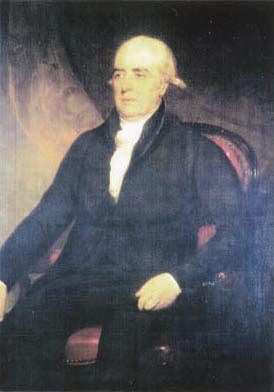
Portraits from the Royal Infirmary of Edinburgh Boardroom
James Hamilton (the elder), 1749-1835
Connection with the Royal Infirmary: Physician-in-Ordinary between 1775-1823
Artist: John Watson Gordon, 1778-1864
Date of Portrait: 1824
Hamilton served for 48 years as "Ordinary Physician to the House". He was first appointed on 20 November 1775 and resigned on 15 December 1823. This portrait was commissioned by the Managers as a tribute to his "unremitting and great professional abilities".
He was the son of an Edinburgh divinity professor, and took his MD at the University in 1771. Hamilton's uncle was a well-known publisher and a prominent member of the Town Council, and this probably ensured that his Edinburgh medical career would be a smooth one. Besides his Infirmary appointment, he was also Physician to George Heriot's, the Merchant Maiden and Trades Maiden Hospitals.
Hamilton's public posts brought him honour, prestige and respect, not only from Managers but also his medical colleagues, students and members of the general public. In later life, after he had retired from public duties, his outmoded style of dress consisting of ruffles, knee britches and a distinctive three cornered cocked hat, ensured he remained a well-known public figure. He was engraved in this fashion by John Kay in the artist's "Edinburgh Portraits", and many local townsfolk referred to him by the soubriquet "Cocky" Hamilton. Hamilton consolidated his medical reputation in two further ways. In 1815 he wrote what was to become one of the standard practical medical textbooks of the age: Observations of the Utility and Administration of Purgative Medicine in Several Diseases. It was largely, but not exclusively, based on cases he had treated at the Infirmary under the watchful eyes of the attending medical students. In the book Hamilton drew attention to the close links between the Infirmary and the University which promoted the development of clinical medicine as well as medical education generally:
"Cases then of this description, which, in their progress, cannot be perverted to particular purposes, and which cannot afterwards be altered, by any retrograde emendation of the practitioner, possess an authenticity peculiar to themselves; and in the establishing of medical facts, may be produced as an authority."
Although Hamilton's heavy reliance upon purgative seems archaic, one-sided and even ridiculous today, it must be set in the context of eighteenth century medical knowledge. The pharmacopoeias of the day were full to the brim with a farrago of medically inert substances, as well as some highly dangerous ones. Hamilton strove to identify simple remedies which genuinely produced an identifiable effect on the patient, and to distinguish between the debilitating effects of stronger substances and those purgatives which enabled the evacuation of the alimentary canal without further loss of body fluids. Viewed in the context of an age of heroic and dangerous remedies, Hamilton was a conservative medical improver.
As a prophylactic measure, Hamilton favoured the pill. colocynth c. aloe; and this compound, based on the bitter pulp and juices of two plants with laxative properties, became widely known as "Hamilton's Pill". In this period, medical men rarely escaped criticism not to say satire, and Hamilton was no exception. His ideas were often ridiculed as too simplistic and among the irreverent, ever-present minority of medical students, "Cocky Hamilton" was also "Back Door" Hamilton. Throughout the eight editions of Observations which appeared during his lifetime, Hamilton strove to defend himself against what he saw as misconception about his practice, and to defend his method of empirically investigating medical facts.
Although Hamilton also had his portrait painted by Henry Raeburn and William Dyce, there seems to have been some reluctance to sit for Watson Gordon, one of Raeburn's pupils. Hamilton replied to the Managers' original request as follows: "I cannot decline your polite request concerning my portrait, but permit me to say that in not doing so, I make some sacrifice of personal feeling." Perhaps there is some suggestion of this in the portrait itself. This is someone not entirely at ease, a self-conscious man sitting, if not on the edge of his seat, then without the support of the red leather back of the chair. As a portrait painter, Watson Gordon was said to emphasise the best side of his sitters' characters and to excel when painting those faces which displayed intellect coupled with a certain shrewdness. In this sense, the portrait and the physician portrayed were well suited to one another.
Designed by the Learning Technology Section, © The University of Edinburgh

